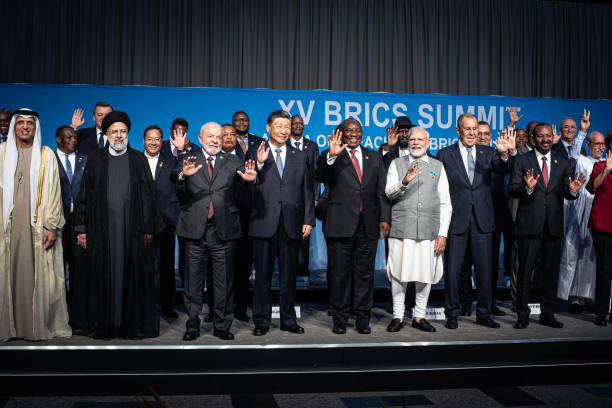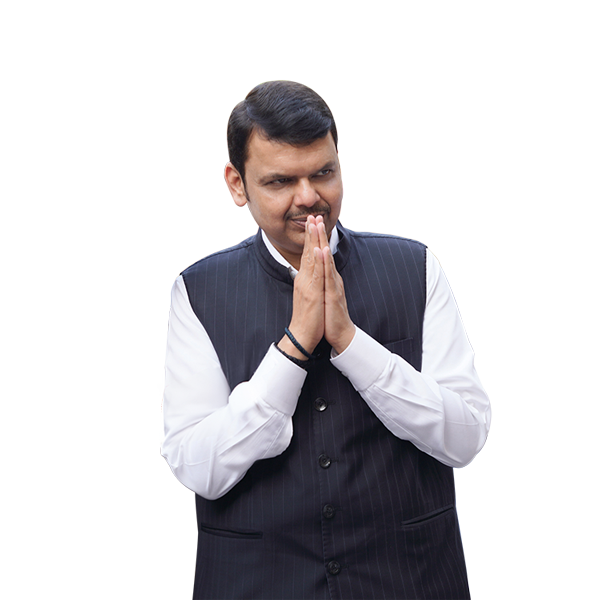
JOHANNESBURG, SOUTH AFRICA – AUGUST 24: South African President Cyril Ramaphosa with fellow BRICS leaders President of Brazil Luiz Inacio Lula da Silva, President of China Xi Jinping, Prime Minister of India Narendra Modi, and Russia’s Foreign Minister Sergei Lavrov pose for a family photo with delegates, including six nations invited to join the BRICS group, Argentina, Egypt, Ethiopia, Iran, the United Arab Emirates and Saudi Arabia, during the closing day of the BRICS Summit at the Sandton Convention Center on August 24, 2023 in the Sandton district of Johannesburg, South Africa. The BRICS summit, held in South Africa between 22-24 August 2023. The BRICS group of major emerging economies is made up of Brazil, Russia, India, China and South Africa. The 15th BRICS Summit, an international relations conference, is being held in South Africa between August 22-24 2023 with the leaders expected to discuss the expansion of the BRICS group and a BRICS currency. It is the first in-person summit of the BRICS nations – Brazil, Russia, India, China and South Africa – since the Covid-19 pandemic. Russian President Vladimir Putin will not be attending the meetings in person due to the ICC, International Criminal Court issued warrant for alleged war crimes. (Photo by Per-Anders Pettersson/Getty Images)
How PM Modi convinced China on LAC patrolling agreement
KAZAN , RUSSIA ,NEW DELHI“The resumption of patrolling of both armies in the Depsang Bulge and Demchok areas of East Ladakh is a result of painstaking negotiations.
The Narendra Modi-Xi Jinping détente over resolving the military friction in East Ladakh post-PLA transgression in May 2020 was actually a test of the staying power of the NDA government, the determination and commitment of the Indian Army in most trying conditions and the complete coordination between the military and Indian diplomacy.
PM Narendra Modi met Chinese President Xi Jinping on the sidelines of the BRICS Summit.
While the Modi-Xi meeting at Kazan took place with both leaders conducting themselves in appropriate manner, the delegation-level talks paved the way for Special Representative Dialogue on negotiating the de-escalation of the military buildup all along the 3488 km Line of Actual Control, while Foreign Ministers of both countries will chart a course for normalization of ties. National Security Advisor Ajit Doval will represent India in the SR dialogue, and Wang Yi, Director of the Chinese Communist Party Central Committee Commission and Foreign Minister will represent Beijing and work towards removing military friction on both sides of the LAC. Wang will also be External Affairs Minister S Jaishankar’s interlocutor in the normalization dialogue.
Crisis mitigation in BRICS
Russia, China, Brazil, Egypt, Ethiopia, India, Iran, Saudi Arabia, South Africa, United Arab Emirates are members of BRICS, one of the strongest organizations in the world. If this group has the power to unite the world, this union also has the power to create a gap between the nations of the world.
The 16th BRICS summit is scheduled to be held in Kazan, Russia, and the summit is a matter of prestige for Russia as the host country after the Ukraine crisis. This summit is also important for India, which is in a veiled fight with China, and knowing the Galwan Valley crisis with China before the BRICS summit can be said to be a diplomatic victory for India. India has also signed some agreements including LAC dispute settlement in the convention. India has once again announced to the world that it will provide all necessary assistance to end the Russia-Ukraine crisis.
Logistics: Russia and China, the world’s 2 superpowers, are partners
BRICS also has countries with the largest oil reserves. If the conflict escalates in the Middle East, it will be easier for India to get fuel oil from this route. All that is pending now is China’s consent to get a permanent seat on the UN Security Council. China’s friendship will be a plus for India. Russia’s cooperation is crucial for the construction of the 2036 space station. If the conflict with China is eased, there is a slim possibility that Nepal will also be removed from the map.
Quad weapon to reduce China’s influence at sea
After the Indian Ocean Tsunami that occurred in 2004, there was thought of creating a global platform for disaster relief efforts. At this time, major countries such as India, Japan, Australia and the United States formed an informal alliance to cooperate in disaster relief efforts. In 2007, the then Japanese Prime Minister Shinzo Abe announced this alliance as the Quadrilateral Security Dialogue (Quad Summit). This union accounts for 35% of the world’s GDP.
Janade: India-China join hands in BRICS alliance
If shaken, India is using the ASEAN summit almost as a move against China. A major objective of the Quad nations is to keep important sea lanes in the Indo-Pacific region free from any influence. The arrow of ‘quad relationship’ is beneficial for India to reduce China’s interference in the maritime domain including the Bay of Bengal. Andaman and Nicobar Islands have also been strengthened by this relationship. India is seeing a lot of technological advantages from America and Japan.
ASEAN is a pillar of trade
India is not a member of the Association of Southeast Asian Nations (ASEAN), an association of 10 South Asian countries that contribute 21% of global GDP. It is a confederation of Indonesia, Malaysia, Philippines, Singapore, Thailand, Brunei, Vietnam, Laos, Myanmar and India is the invited country of this confederation.
At the recently held ASEAN Summit in Jakarta, Indonesia, Prime Minister Modi proposed 12 points to strengthen ASEAN-India cooperation, with counter-terrorism at the fore. The Prime Minister also emphasized the importance of establishing multi-modal connectivity and economic corridors connecting India, South Asia, West Asia and Europe.
Transit: ASEAN countries to debt diplomacy
India’s relationship is an inescapable bite for China, which is falling apart. It is also a setback to China’s expansionist, Silk Road dream. India’s trade relations with ASEAN countries have reached further heights.
The world’s most powerful alliance is the G20
G20 is a prestigious alliance for India, which is a group of powerful countries that share 85% of the world’s GDP. Mainly the international financial system, the global economy, infrastructure investment, sustainable finance, international taxation, health and finance, regulatory issues of the financial sector and financial inclusion are discussed here.
The Asia-Pacific countries of Australia, China, India, Indonesia, Japan, South Korea, France, Germany, Italy, Russia (currently suspended), Turkey, UK, North American Canada and USA, South American Argentina, Brazil, Middle Eastern Saudi Arabia and South Africa are part of the G20 alliance. Since India got the presidency of the union last year, India got world recognition by organizing meetings in different parts of the country throughout the year.
Janade: Kashmir belongs to India through G20 summit in Srinagar
India has told the world that it is an integral part. It has also used the platform to condemn Pakistan-sponsored terrorism. India has tried to understand the problems of developing countries, their commercial needs and complexities. India has convinced Canada of its respect in the world’s diplomatic nexus .
The world of knowledge is a nest of instability. On the one hand, the Russia-Ukraine war continues, on the other, the Middle East crisis is worrying the world day by day. On the other hand, North Korea and South Korea have been carrying weapons across their borders and scrambling. Meanwhile, the dollar is headed for volatility. Mutually shrinking trusts between countries, diplomatic sneers at daybreak… Thus mountains of crisis are arising in the world.
There are also tens of groups in this world which are identified as various factions. Many countries continue to make efforts to increase diplomatic relations by forming alliances with countries that are compatible with their mentality. Looking at this agreement and relations, the other bloc nation is weaving other strategies. It is significant that other countries, apart from India, do not have the wisdom to move forward while maintaining a good relationship with everyone’s mentality. This balance of India’s diplomacy as a reliable country in the friendly zone of America and in the Russia-China zone is also the great magic of Prime Minister Narendra Modi.
BRICS, ASEAN, G20… India has occupied a crucial position in many gatherings of the world where the inclinations and positions are different. When the world is divided in war crisis, India is trying to compensate for its relationship with everyone. What are the results of this ‘diplomatic balance’ of PM Modi?
Will India revive the SAARC alliance? Includes India, Afghanistan, Pakistan, Nepal, Bhutan, Bangladesh, Sri Lanka and Malmeems.
SAARC (South Asian Association for Regional Co-operation)
The union has lost its importance now. The basic objective of this organization is to help each other in achieving economic, social, technological and cultural development along with emphasis on collective self-reliance. The last conference was the 18th SAARC conference held in Nepal in 2014. After that, in 2016, a conference was organized in Islamabad, and apart from curbing terrorism, India will hold talks in Pakistan.
The SAARC conferences stopped because they took a firm stand that they would not participate in this conference. Janade: India’s SAARC stance was largely successful in labeling Pakistan a terrorist nation.





